#Thomas Murray Collection
Text


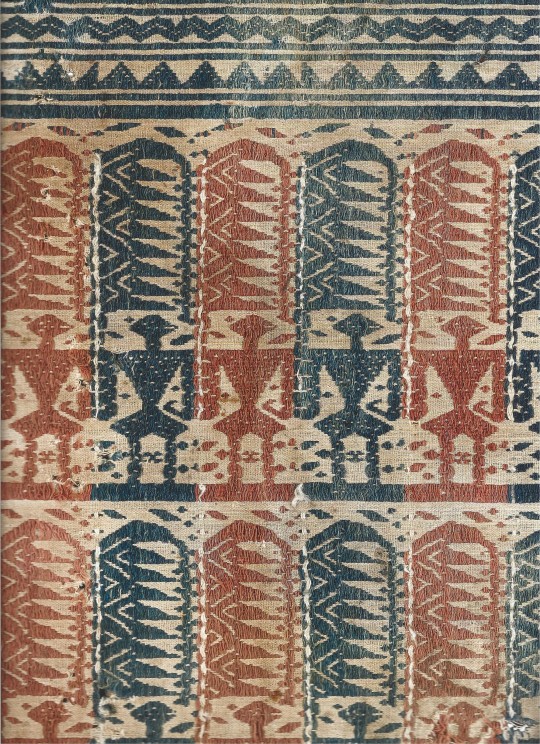


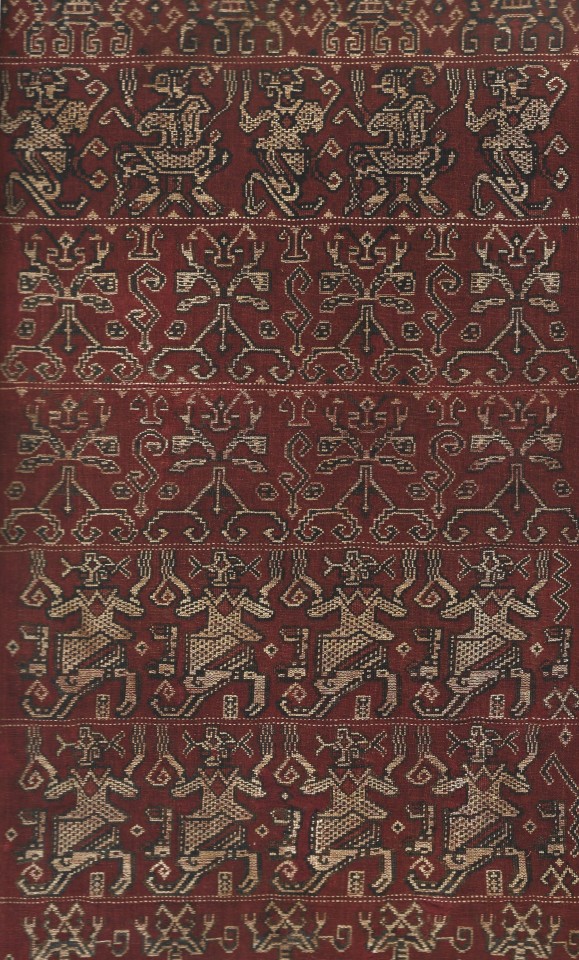
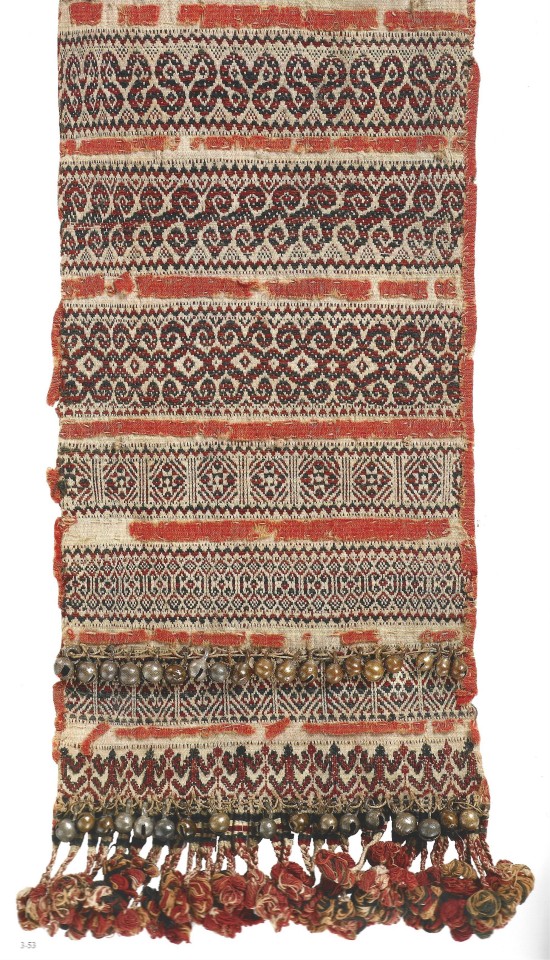


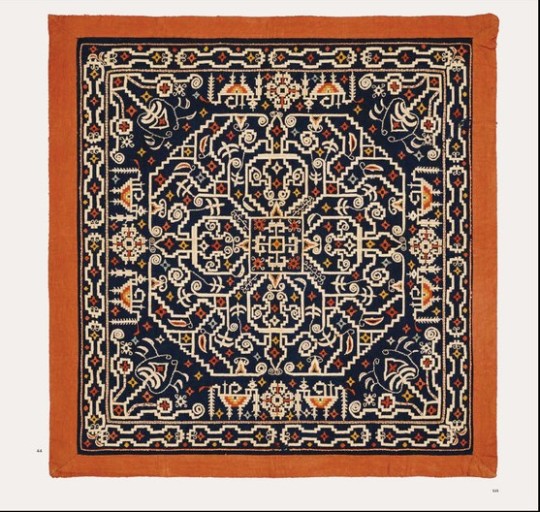
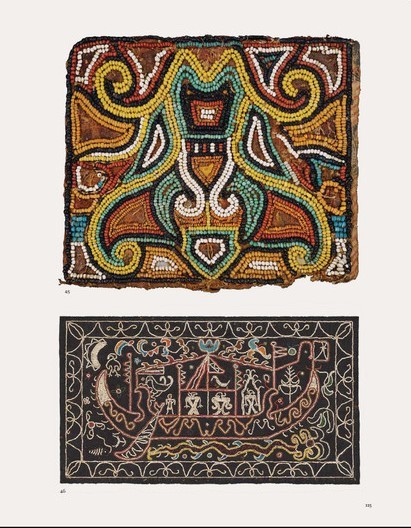
Textiles of Indonesia
The Thomas Murray Collection
Contributors: Lorraine Aragon, Joanna Barrkman, Chris Buckley, Kristal Hale, Valerie Hector, Janet Alison Hoskins, Itie van Hout, Eric Kjellgren, Fiona Kerlogue, Brigitte Khan Majlis, Robyn Maxwell, Thomas Murray, and Sandra Sardjono
Prestel, London 2021, 534 pages, 26,5x35cm, ISBN 9783791387659
€112,00
email if you want to buy [email protected]
Gathered over the course of four decades, the Thomas Murray collection of Indonesian textiles is one of the most important in the world. The objects comprise ritual clothing and ceremonial cloths that tell us much about the traditions of pre-Islamic Indonesian cultures, as well as the influences of regional trade with China, India, the Arab world, and Europe. As with the earlier volume, Textiles of Japan (Prestel, 2018), the book focuses on some of the finest cloths to come out of the archipelago, presenting each object with impeccable photographs. Geographically arranged, this volume pays particular attention to textiles from the Batak and the Lampung region of Sumatra, the Dayak of Borneo, and the Toraja of Sulawesi, as well as rare textiles from Sumba, Timor and other islands. Readers will learn about the intricate traditions of dyeing, weaving, and beading techniques that have been practiced for centuries. Original texts by international experts offer historical context, unspool the mysteries behind ancient iconography, and provide new insights into dating and provenance. At once opulent and scholarly, this book arrives at a moment of growing interest in Southeast Asian culture and carries the imprimatur of one of the art world's leading collectors.
02/11/23
#Textiles Indonesia#Thomas Murray Collection#Batak and Lampung region#Sumatra#Dayak Borneo#Toraja Sulawesi#Sumba textiles#Timor Textiles#Indonesian Textiles#textiles books#fashionbooksmilano
22 notes
·
View notes
Text
Fishskin Robes of the Ethnic Tungusic People of China and Russia
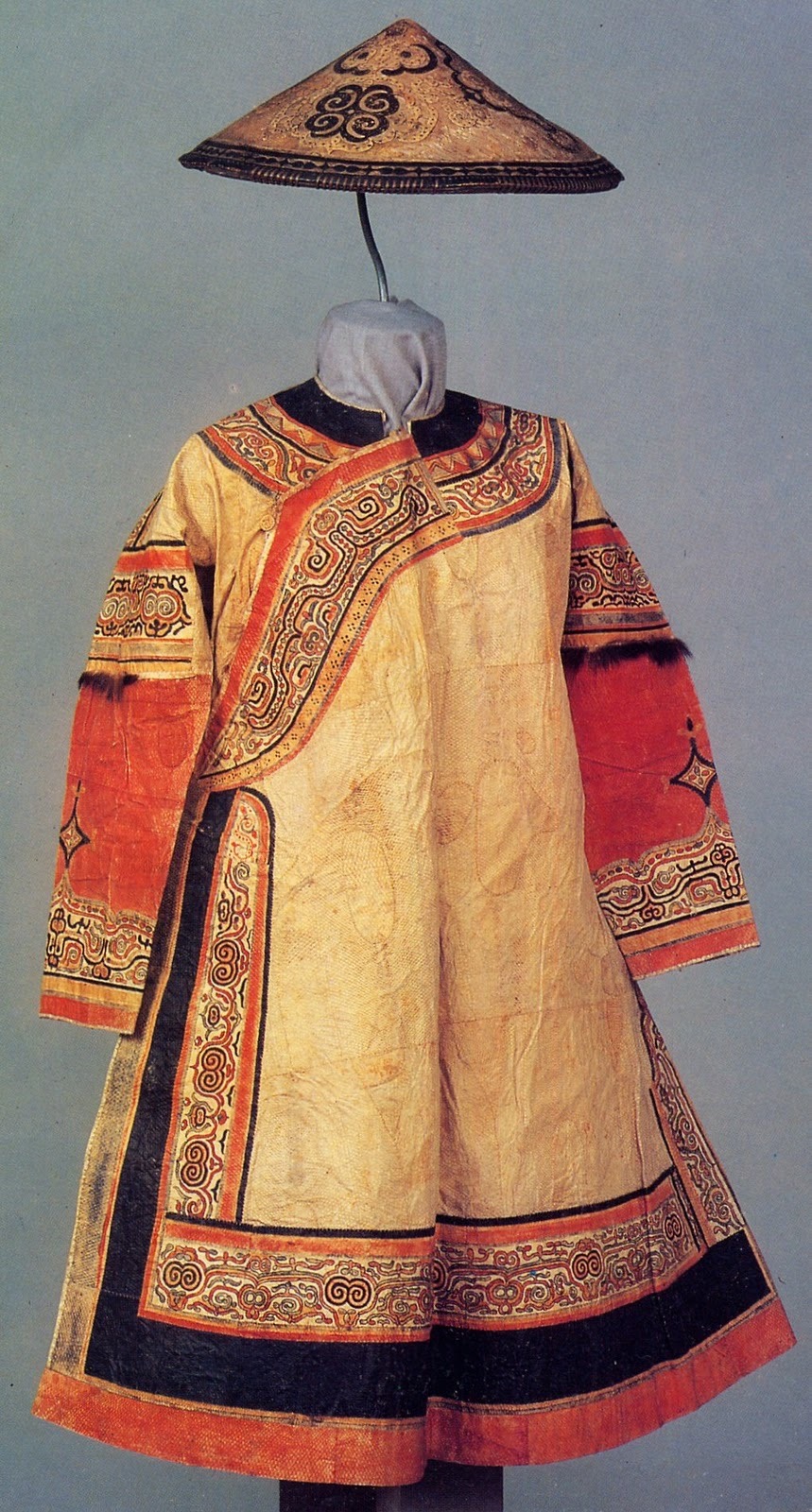
Oroch woman’s festive robe made of fish skin, leather, and decorative fur trimmings [image source].
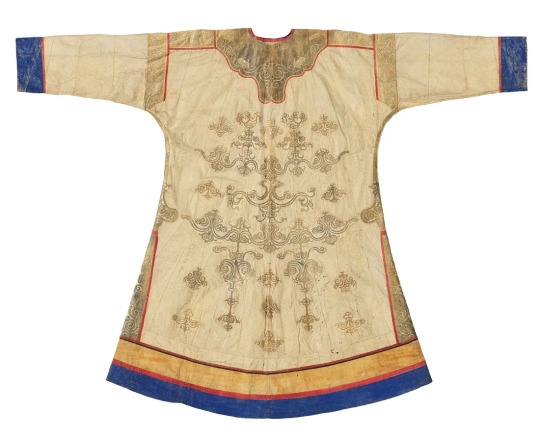
Nivkh woman’s fish-skin festival coats (hukht), late 19th century. Cloth: fish skin, sinew (reindeer), cotton thread; appliqué and embroidery. Promised gift of Thomas Murray L2019.66.2, Minneapolis Institute of Art, Minnesota, United States [image source].
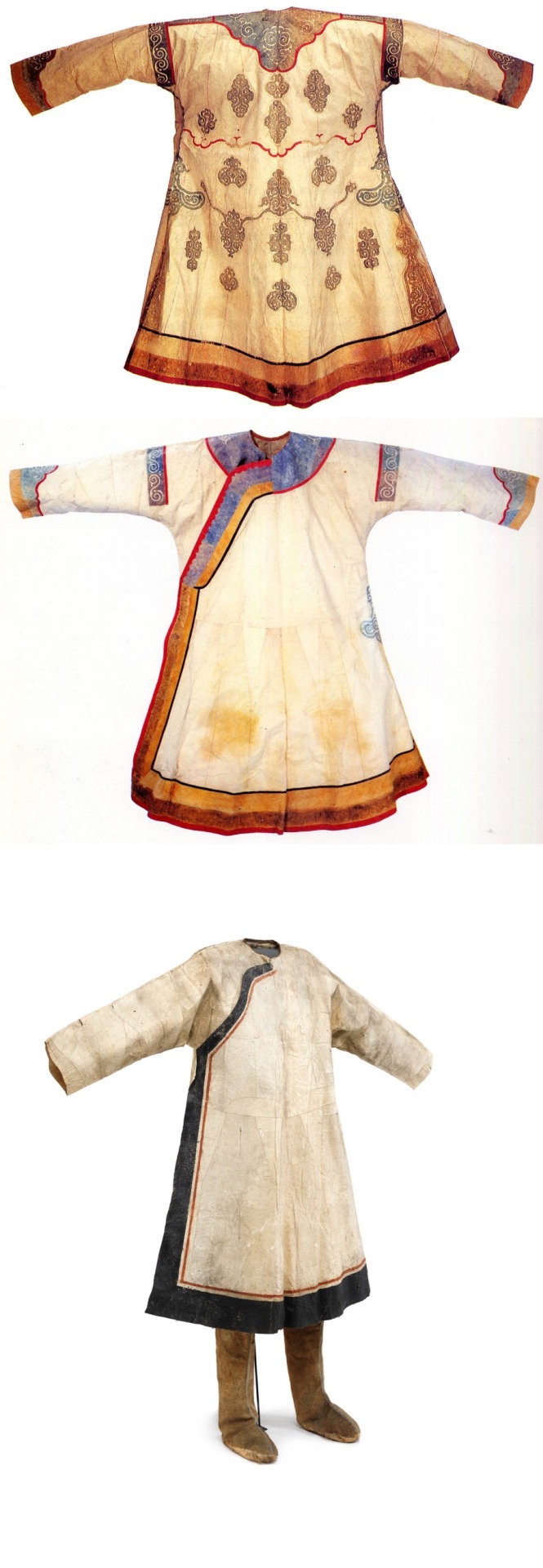
Back view of a Nivkh woman’s robe [image source].
Front view of a Nivkh woman’s robe [image source].
Women’s clothing, collected from a Nivkh community in 1871, now in the National Museum of Denmark. Photo by Roberto Fortuna, courtesy Wikimedia Commons [image source].
The Hezhe people 赫哲族 (also known as Nanai 那乃) are one of the smallest recognized minority groups in China composed of around five thousand members. Most live in the Amur Basin, more specifically, around the Heilong 黑龙, Songhua 松花, and Wusuli 乌苏里 rivers. Their wet environment and diet, composed of almost exclusively fish, led them to develop impermeable clothing made out of fish skin. Since they are part of the Tungusic family, their clothing bears resemblance to that of other Tungusic people, including the Jurchen and Manchu.
They were nearly wiped out during the Imperial Japanese invasion of China but, slowly, their numbers have begun to recover. Due to mixing with other ethnic groups who introduced the Hezhen to cloth, the tradition of fish skin clothing is endangered but there are attempts of preserving this heritage.
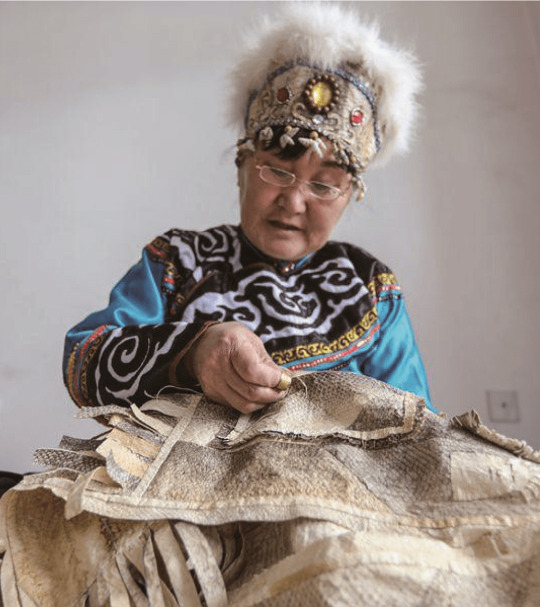
Hezhen woman stitching together fish skins [image source].


Top to bottom left: You Wenfeng, 68, an ethnic Hezhen woman, poses with her fishskin clothes at her studio in Tongjiang, Heilongjiang province, China December 31, 2019. Picture taken December 31, 2019 by Aly Song for Reuters [image source].
Hezhen Fish skin craft workshop with Mrs. You Wen Fen in Tongjian, China. © Elisa Palomino and Joseph Boon [image source].
Hezhen woman showcasing her fishskin outfit [image source].
Hezhen fish skin jacket and pants, Hielongiang, China, mid 20th century. In the latter part of the 20th century only one or two families could still produce clothing like this made of joined pieces of fish skin, which makes even the later pieces extremely rare [image source].
Detail view of the stitching and material of a Hezhen fishskin jacket in the shape of a 大襟衣 dajinyi or dajin, contemporary. Ethnic Costume Museum of Beijing, China [image source].
Hezhen fishskin boots, contemporary. Ethnic Costume Museum of Beijing, China [image source].
Although Hezhen clothing is characterized by its practicality and ease of movement, it does not mean it’s devoid of complexity. Below are two examples of ornate female Hezhen fishskin robes. Although they may look like leather or cloth at first sight, they’re fully made of different fish skins stitched together. It shows an impressive technical command of the medium.
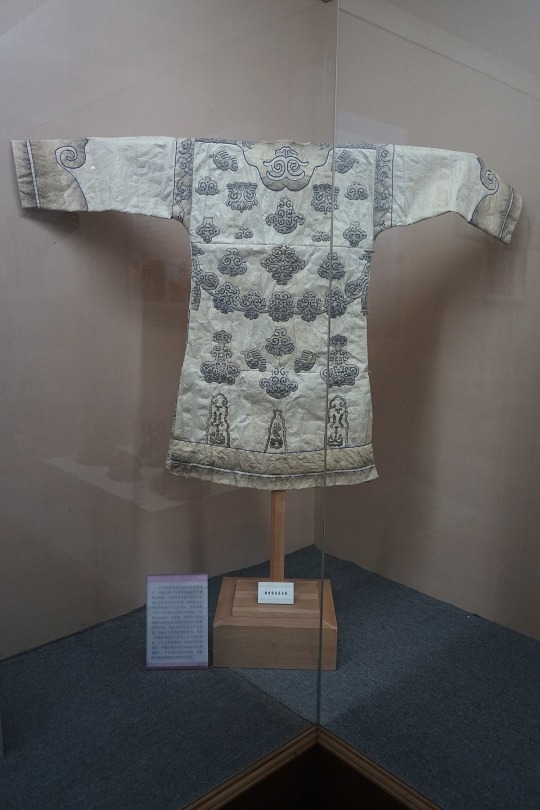
赫哲族鱼皮长袍 [Hezhen fishskin robe]. Taken July 13, 2017. © Huanokinhejo / Wikimedia Commons, CC BY 4.0 [image source].
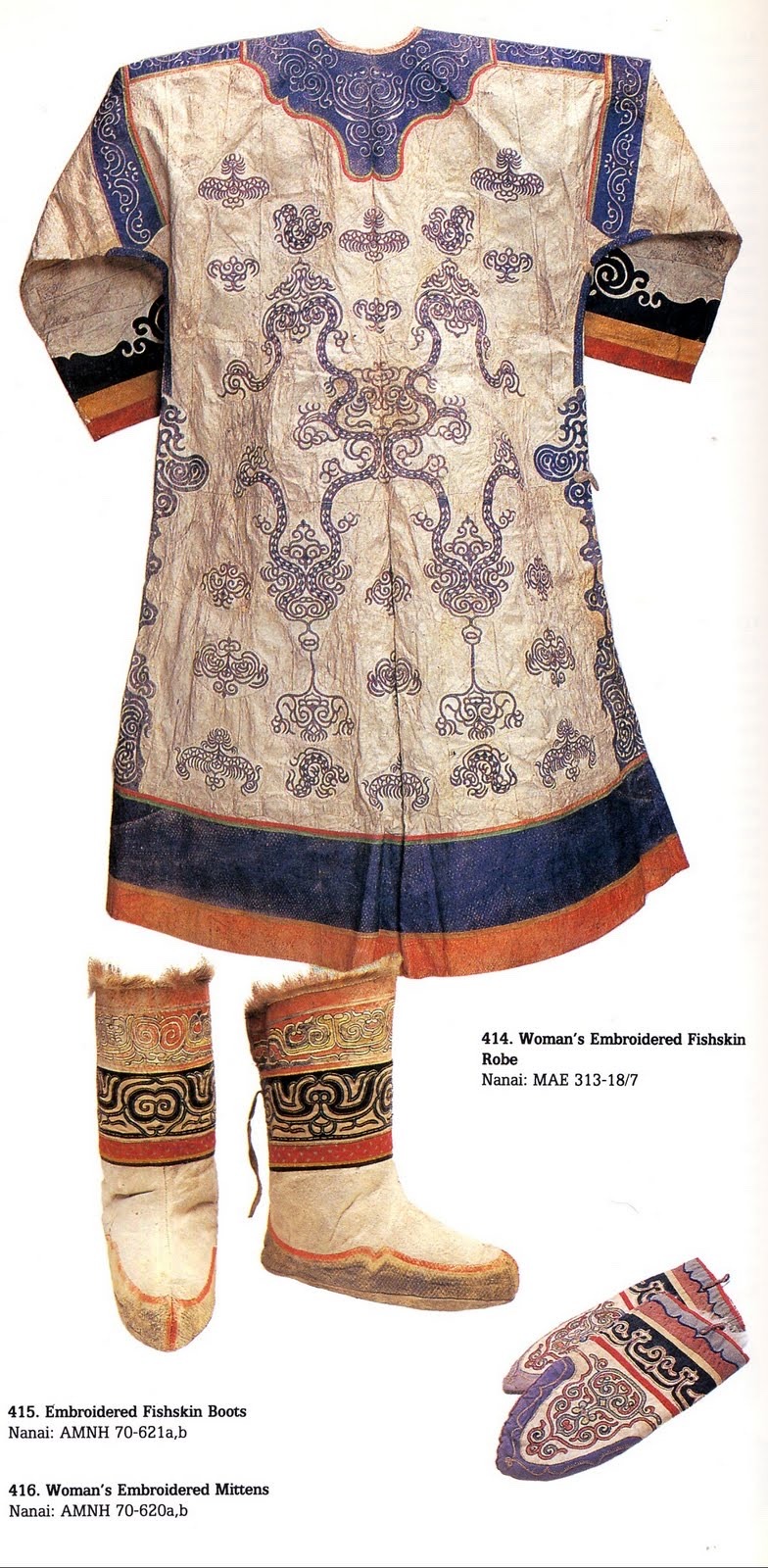
Image containing a set of Hezhen clothes including a woman’s fishskin robe [image source].
The Nivkh people of China and Russia also make clothing out of fish skin. Like the Hezhen, they also live in the Amur Basin but they are more concentrated on and nearby to Sakhalin Island in East Siberia.


Top to bottom left: Woman’s fish-skin festival coat (hukht) with detail views. Unknown Nivkh makers, late 19th century. Cloth: fish skin, sinew (reindeer), cotton thread; appliqué and embroidery. The John R. Van Derlip Fund and the Mary Griggs Burke Endowment Fund; purchase from the Thomas Murray Collection 2019.20.31 [image source].
Top to bottom right: detail view of the lower hem of the robe to the left after cleaning [image source].
Nivkh or Nanai fish skin boots from the collection of Musée du quai Branly -Jacques Chirac. © Marie-Lan Nguyen / Wikimedia Commons, CC BY 4.0 [image source].
Detail view of the patterns at the back of a Hezhen robe [image source].
Read more:
#china#russia#tungusic#hezhe#nanai#fishskin#ethnic minorities#nivkh#chinese culture#history#russian culture#amur basin#heilongjiang#east siberia#ethnic clothing
977 notes
·
View notes
Text
Indycar Driver Lore Master List
What is driver lore? A collection of stats, pictures, trivia, a curated list of links to social media/YouTube and more. All you need to get started on getting to know the drivers of the 2023 Indycar field.
Josef Nicolai Newgarden
Scott Thomas McLaughlin
Conor James Daly
Alexander Michael Rossi
James Douglas Meredith Hinchcliffe
Felix Rosenqvist
Patricio "Pato" O'Ward Junco
David Joseph Malukas
Álex Palou Montalbo
Kyle MacLean Kirkwood
Colton Thomas Herta
Rinus VeeKay
Christian Lundgaard
Callum Benjamin Ilott
Marcus John Armstrong
William "Will" Steven Power
Scott Ronald Dixon
Simon Pagenaud
Hélio Castroneves
Marcus Thorbjörn Ericsson
Tony Kanaan
RC Enerson
Ed Carpenter
Stefan James Wilson
Ryan Christopher Hunter-Reay
Santino Michael Ferrucci
Katherine Anne Legge
Graham Robert Rahal
Takuma Sato
Marco Michael Andretti
Benjamin Pederson
Jack Joseph Murray Harvey
Agustín Hugo Canapino
Sting Ray Robb
Devlin Defrancesco
Romain David Jeremie Grosjean
George Dario Marino Franchitti
Indycar - Social Media
Indycar Drivers gym/trainer preferences
#indycar rpf#indycar#fanfic#Driver Lore#josef newgarden#scott mclaughlin#conor daly#alexander rossi#james hinchcliffe#felix rosenqvist#pato o'ward#david malukas#alex palou#kyle kirkwood#colton herta#rinus veekay#christian lundgaard#callum ilott#marcus armstrong#will power#scott dixon#simon pagenaud#helio castroneves#marcus ericsson#tony kanaan#rc enerson#ed carpenter#stefan wilson#ryan hunter reay#katherine legge
115 notes
·
View notes
Text
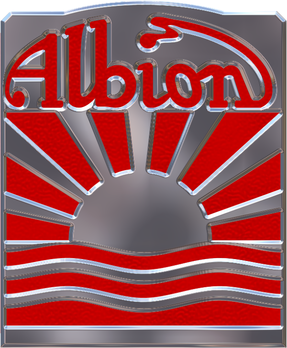





On December 30th 1899 the Albion Motor Company was established.
When we think of car manufacturers nowadays, even going back to the likes of Linwood and the Hillman Imp in the 60's was made and designed by Rootes, an English company, Albion was all Scottish, from the people who formed the company, to the workers on the floor and those that bought the products
The Albion Motor Company was founded, initially with seven employees, at Finnieston Street in Glasgow, the firm was started by Thomas Blackwood Murray and Norman Osbourne Fulton and initially produced both cars and commercial vehicles, switching to the production of military vehicles during World War One.
The firm was originally named the Albion Motor Car Company and re-named Albion Motors in 1930. In the 50's, the firm amalgamated with Leyland Motors.
The firm's first car, built in 1900, was a cart powered by an eight horse-power engine, with solid tyres. By 1915, the company had five different models in production. The motor trade must have ran in the blood of Fulton's family, his cousin, George Johnston is credited with building Scotland's first car in 1895, called the "mo-car" It was also the first to be built in the United Kingdom.
Albion Motors switched to mainly commercial vehicles production in the years before World War I, producing trucks and buses, including bus models Valiant, Victor and Viking.
In 1957, Lancashire-based Leyland Motors acquired Albion Motors as the first step in an expansionist policy, which saw famous names like Scammell, A.E.C. and Guy succumb. Albion Motor’s name was changed, rather ignominiously, to Leyland (Glasgow) and later, in 1987, to Leyland-DAF.
1993 saw a management buy-out that brought Albion Automotive, as it then became known, back into Scottish ownership. Since 1998, Albion Automotive has been a subsidiary of American Axle & Manufacturing, and manufactures axles, driveline systems, chassis systems, crankshafts and chassis components out of its premises on South Street, which it took over from the neighbouring Coventry Ordnance Works in 1969.
Today, you can visit the Biggar, & Upper Clydesdale Museum and see the biggest collection of Albions in the world, also check the website here https://www.biggarmuseumtrust.co.uk/albion-car-comes.../....
9 notes
·
View notes
Photo
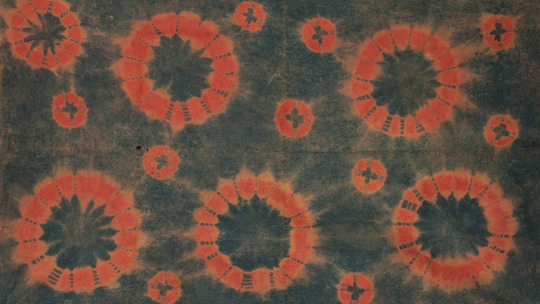
Mosen Tea Ceremony Cloth, Mongolia for the Japanese Market, 19th century. Felting technique on wool. Collection of Thomas Murray.
Photograph by Robert Bengtson.
27 notes
·
View notes
Photo

If you can get to Minneapolis, go see "Dressed by Nature: Textiles of Japan" with the collection of Thomas Murray at the Minneapolis Institute of Art.
184 notes
·
View notes
Text
10 best royal exhibitions to continue the Coronation celebrations, from Buckingham Palace to Blenheim
The day of the Coronation is over but these remarkable royal exhibitions across the UK means the excitement doesn’t need to be
By Natasha Leake
18 May 2023
The glow from King Charles III’s Coronation is starting to fade, but there is plenty more pomp and ceremony to be discovered at these extraordinary royal exhibitions currently being staged across the country.
Stately homes and royal palaces have transformed their sumptuous rooms into backdrops for stunning showcases of royal regalia, period costumes and mementos of past Coronations.
From Blair Castle to Castle Howard; Blenheim to Buckingham Palace, book a date at one of these must-see royal exhibitions to keep the celebrations going.
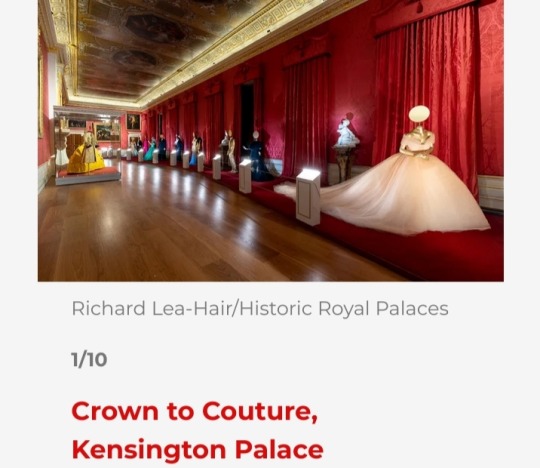
Through a carefully curated selection of more than 200 pieces, the Kensington Palace fashion exhibition draws parallels between the pomp, ceremony and performance of the contemporary red carpet and the pressure to ‘see and be seen’ at Georgian court.
One-of-a-kind creations worn by Lizzo, Katy Perry and Lady Gaga et al. are juxtaposed with outfits worn by 18th century movers and shakers in the State Apartments, which, handily, is where the showcase is staged.
Pictured: A row of magnificent outfits in the King’s Gallery at the Crown to Couture
5 April - 31 October 2023
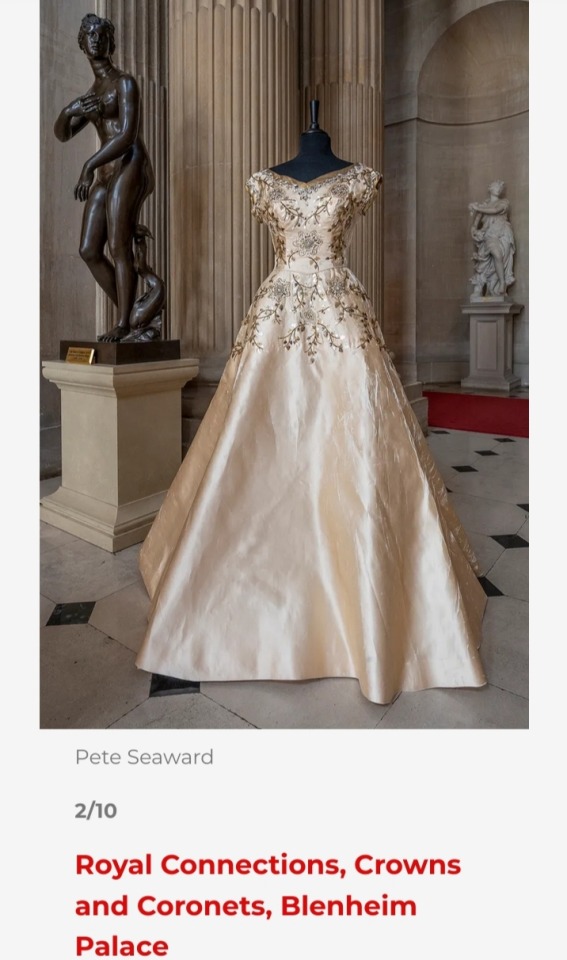
Blenheim Palace is using the occasion of the Coronation to celebrate its historic connection with the Royal Family.
With a collection of previously unseen artefacts, crowns, coronets, robes, and photo albums, take a trip into the world of royal fashion with an impeccably restored Norman Hartnell silk gown, worn by the then Rosemary Spencer-Churchill to the Queen’s Coronation in 1953.
Also on display are costumes from Bridgerton and The Crown, and a page from a Blenheim visitor’s book, which includes the elegant inked signatures of Wallis Simpson (the future Duchess of Windsor) and her second husband, Ernest A. Simpson.
Pictured: The restored Maid of Honour Coronation dress worn by Rosemary Spencer-Churchill to the Coronation of Queen Elizabeth II in 1953.
19 March - 30 July 2023

Originally launched in 2022, the award-winning Castle Couture exhibition returns this summer to Blair Castle, the ancestral home of the Atholl family, with an extended edition that showcases statement designs, intricate embroidery, innovative textiles, and style influences from the 18th century through to the 20th century.
Among the highlights are delightfully delicate ostrich feather and Brussels lace fans by the renowned Parisienne craftsman Duvelleroy, the appointed supplier to Queen Victoria.
There are also pieces from the personal collection of the late Katharine Stewart-Murray, Duchess of Atholl, Scotland’s first Scottish female Member of Parliament.
Pictured: This ballgown would have been worn by Lady Glenlyon (later Anne, Duchess of Atholl) during the visit as they dined with the royal couple.
1st April – 28th October 2023
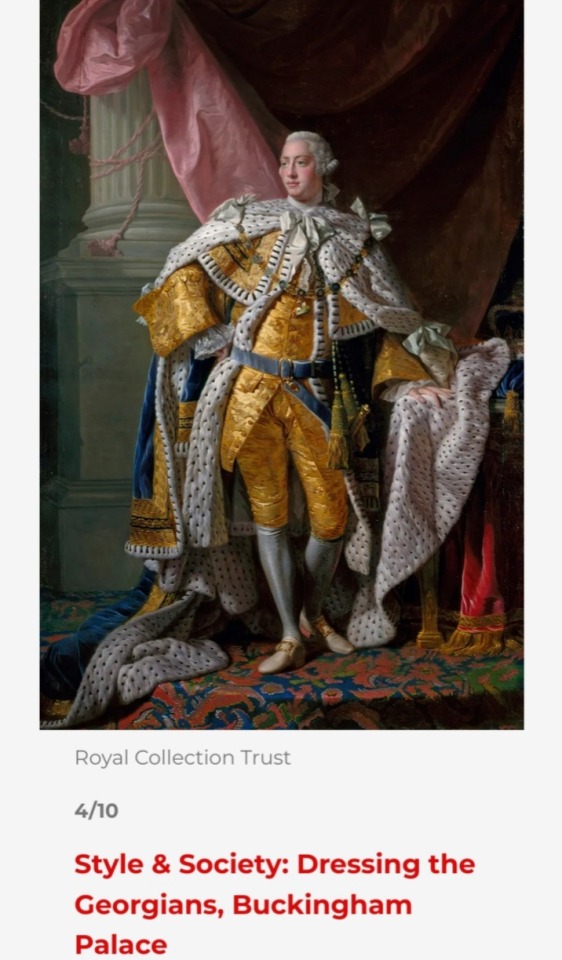
In a homage to the Regency period, visitors are invited to take a step back into the world of the Georgians with an exhibition that looks at how fashion trends reflected the significant trade, travel and technological advances of the period.
A highlight of the exhibition is a rarely displayed, full-length portrait of Queen Charlotte (of Bridgerton fame) by Thomas Gainsborough, dated from around 1781, which usually hangs in the White Drawing Room at Windsor Castle.
The showcase also features one of the earliest surviving British royal wedding dresses: a stunning gown worn by Princess Charlotte of Wales in 1816.
Pictured: A painting of King George III by Allan Ramsay, c.1761–2.
21 April – 8 October 2023

The late Queen Elizabeth II’s beloved corgis captured the hearts of the nation the late monarch’s funeral.
Now they are being celebrated as part of a free exhibition at the Wallace Collection, in central London.
The one-room display features touching imagery of the Queen with her corgis.
It coincides with the museum’s exhibition, ‘Portraits of Dogs: From Gainsborough to Hockney,’ which celebrates human devotion to dogs over the centuries through a carefully curated selection of 50 paintings, sculptures, drawings and taxidermy.
Pictured: Queen Elizabeth II sitting on rocks on the Garbh-allt Burn with two corgis on the Estate at Balmoral Castle, Scotland, September 1971
8 March – 25 June 2023
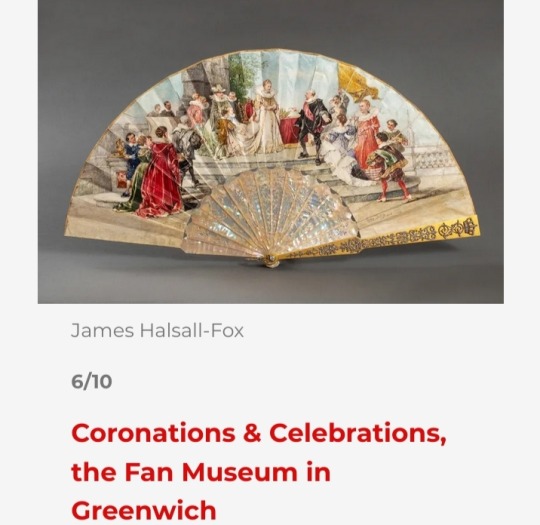
Situated in a pair of beautifully restored early Georgian townhouses, the exhibition showcases centuries of royal fans from across the globe, including a special, printed, English fan marking the restoration of Charles II and the contemporary fans made by The Fan Museum in honour of the late Queen Elizabeth II’s Diamond Jubilee.
The exhibition promises to be ‘not merely a look back on what has been but a rally of hope for what is to come.’
King Charles III has also taken an avid interest in the Fan Museum’s work.
Pictured: A Belgian folding fan dating from 1881
1 February - 24 June 2023
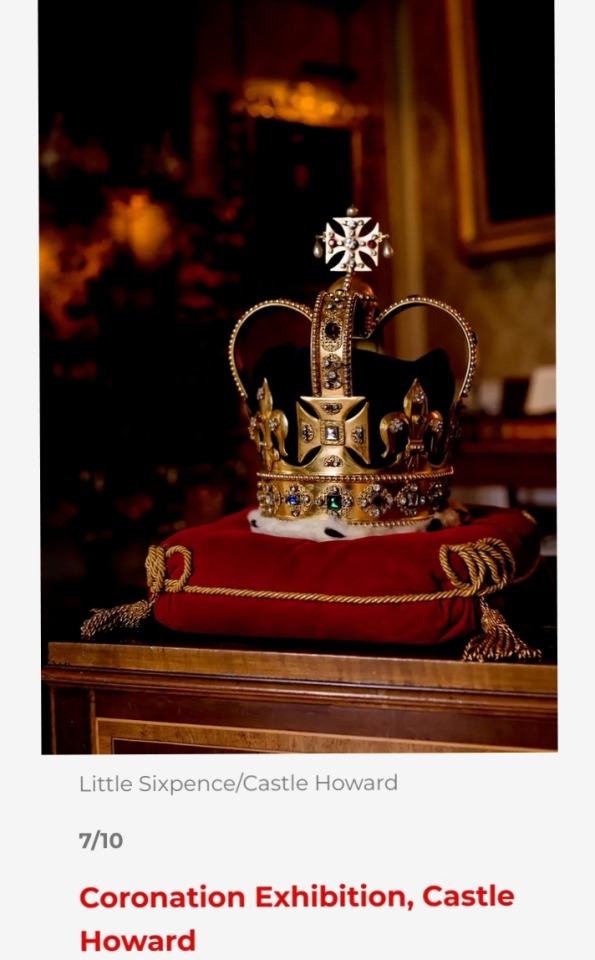
The Long Gallery at Castle Howard, home to the Howard family for more than 300 years, is hosting an incredible exhibition featuring an exact replica of the Crown Jewels and peers’ robes worn to coronations gone by.
Set in 10,000 glorious acres on the edge of the Yorkshire moors, Castle Howard was commissioned in 1699 by the 3rd Earl of Carlisle from Sir John Vanbrugh, who later conceived Blenheim Palace.
The 1st Earl of Carlisle was descended from Lord William Howard, the youngest son of Thomas Howard, 4th Duke of Norfolk (the current Duke of Norfolk organised the King and Queen’s Coronation).
Pictured: Castle Howard’s replica of the Crown Jewels
From April 1

During the last Coronation, the hotel had to secure extra flagpoles in order to fly banners for the many different royals and dignitaries staying there.
The archive overflows with Coronation material, which is why Claridge’s unveiled a space showcasing the hotel’s status as ‘the Royal Hostelry.’
Mementos on display include pages from Queen Victoria’s diary, fans created for the coronation of King George V and Queen Mary, and Claridge’s menus and cocktail cards created for the coronations of King George VI in 1937 and Queen Elizabeth II in 1953.
Pictured: A collection of royal mementos including featuring a book of 53 photographs of the then Prince of Wales, and an order of service from the Coronation of Queen Elizabeth II
Until May 31
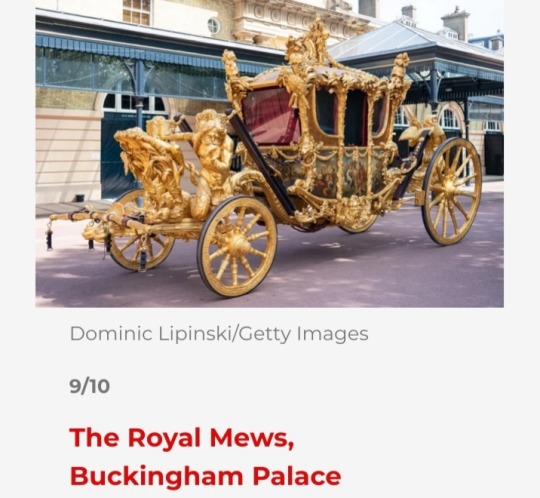
The world watched in awe as the newly crowned King Charles III and Queen Camilla processed from Westminster Abbey back to Buckingham Palace in the Gold State Coach.
This extraordinary regal treasure is available to view at the Royal Mews at Buckingham Palace, alongside the Diamond Jubilee State Coach, which transported Their Majesties to the Abbey ahead of the service.
Also housed in the mews? The famous Windsor Grey horses, which drew the magnificent carriages on the day.
Pictured: The Gold State Coach
2 March - 30 October 2023

At the epicentre of the Coronation was Westminster Abbey. So where better to delve into the gilded history of the captivating service?
A new exhibition in the Chapter House reveals the key elements of the royal ceremony, which has taken place at the Abbey for nearly a thousand years.
Featuring historic illustrations and archive photography, it promises to unpack and explain the Coronation’s magnificent ceremonial regalia and objects.
8 April - 30 September 2023
#King Charles III#Coronation 2023#Kensington Palace#Blenheim Palace#Rosemary Spencer-Churchill#Queen Elizabeth II#Queen’s Coronation 1953#Blair Castle#Castle Couture#Atholl family#Duvelleroy#Queen Victoria#Katharine Stewart-Murray#Regency Period#Thomas Gainsborough#Windsor Castle#Princess Charlotte of Wales#Lady Glenlyon#King George III#corgis#Wallace Collection#royal fans#The Fan Museum#Howard Castle#Earl of Carlisle#Duke of Norfolk#Claridge's#Royal Mews#Westminster Abbey#Windsor Grey horses
20 notes
·
View notes
Text
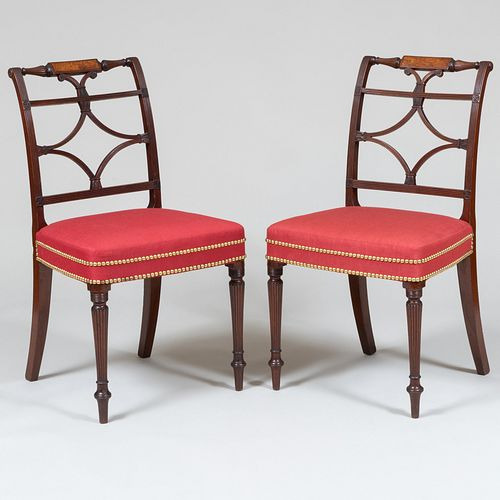
Fine Pair of Federal Carved Mahogany and Inlaid Satin Birch Side Chairs, Attributed to John and Thomas Seymour, Boston, Massachusetts.
35 x 19 1/4 x 19 in., seat height 18 3/4 in.
Note: This pair of chairs represents a fourth variation of Thomas and John Seymour's curved diamond back chairs. The same style is illustrated in Robert Mussey Jr.'s work, The Furniture Masterworks of John & Thomas Seymour (Salem, Massachusetts: Peabody Essex Museum distributed by University Press of New England, 2003), on pp. 388-9, no. 127. Mussey explains this chair is "the sole example found during [his] study that was designed for full over-the-rail upholstery."
Sold at Sotheby's New York in 2004, these chairs were from The Collection of Alice and Murray Braunfeld. A single chair, of the same style and attributed to John Seymour, is in the collection of the Los Angeles County Museum of Art (LACMA). It is listed as a gift of Mrs. Murray Braunfeld in 2006 (M.2006.51.21). Although it is rare that sets of these chairs remain, given the fragile nature of their construction, it is probable this pair and the single chair at LACMA are related.
Two similar pairs of chairs probably by Thomas and John Seymour sold at Sotheby's New York in Property from the Collection of Dr. Larry McCallister, September 22, 2022, lots 98 and 99.
According to Sotheby's catalog note: "The masterful execution and carefully conceived design of this side chair places it among the most sophisticated examples of scroll-back chairs made in Boston. The exquisite combination of light and dark woods, reeding and carving, and rectangles, quarter ellipses and diamonds results in a tour de force of the Federal aesthetic.
The same overall configuration, wood combination and exceptional craftsmanship is found on chairs attributed to John and Thomas Seymour of Boston, whose furniture epitomizes the height of workmanship in Boston during the Federal period. Several similar sets of seating furniture are known. Once is represented by two settees and a pair of side chairs at Winterthur and a pair of side chairs at the Museum of Fine Arts, Boston, all with out-turning front legs (see Charles Montgomery, American Furniture, The Federal Period, nos. 37-9, pp. 90-2 and Edwin Hipkiss, M. and M. Karolik Collection of Eighteenth-Century American Arts, 1941, no. 116). A chair at Bayou Bend and one at Yale University also with out-turning front legs offer another variation (see David Warren, et al, American Decorative Arts and Paintings in the Bayou Bend Collection, 1997, F157, p. 99 and Patricia Kane, 300 Years of American Seating Furniture, 1976, no. 154, p. 174). Additional examples of the form representing two different sets are in the Kaufman Collection and the Henry ford Museum (see J. Michael Flanigan, no. 48, p. 134-5 and Vernon Stoneman, A Supplement to John and Thomas Seymour, Boston, 1965, no. 57).
Another side chair of this type in the Kaufman Collection displays ring-turned reeded tapering legs related to those on this pair of side chairs (see Flanigan, no. 47, p. 132-3). Similar legs appear on an octagonal center table attributed to the Seymours that sold at Sotheby's, Sinking Spring Farms: The Appell Family Collection, January 18, 2003, sale 7867, Lot 1265.
Condition
Both in overall good condition with expected nicks and wear. One with small repairs to the back splat. Both with old repairs and replacements to the upper section of the front legs. New corner blocks underneath the seat. Finely carved and structurally sound.
Stair Galleries, Americana sale 8/10/2023.
12 notes
·
View notes
Text
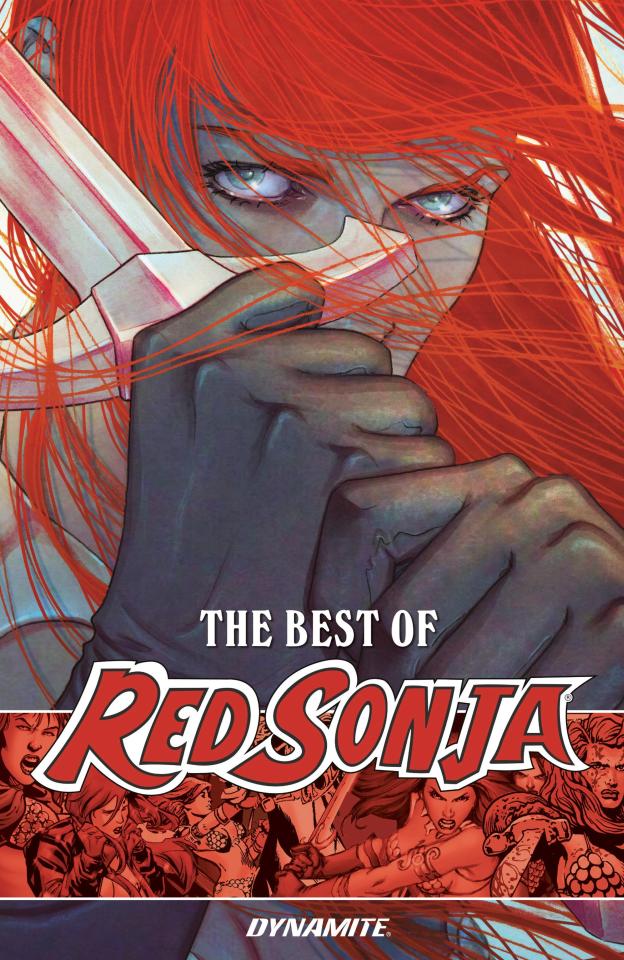
What better way to celebrate the 50th anniversary of the She-Devil With a Sword than to revisit her greatest tales in an all-new hardcover collection? Brought together for the first time in a single volume, these storied sagas trace the legendary exploits of the Hyboria’s favorite daughter over five skull-smashing, tavern-wrecking decades!
From her earliest comic book appearances in Marvel Feature and the very first Red Sonja series — penned by such legendary talents as ROY THOMAS and FRANK THORNE — to her contemporary epics crafted by celebrated scribes like GAIL SIMONE, MICHAEL AVON OEMING, and LUKE LIEBERMAN and artistic titans like WALTER GEOVANNI, MEL RUBI, and LIAM SHARP, The Best of Red Sonja brings readers more than 350 pages of crimson-maned classics — including:
“The Temple of Abomination!” — Roy Thomas & Dick Giordano
“Red Sonja” — Roy Thomas & Esteban Maroto
“The Blood of the Unicorn” — Roy Thomas, Ed Summer, Clara Noto & Frank Thorne
“The Day of the Sword” — Roy Thomas, Doug Moench, Dick Giordano & Terry Austin
“The Message” — Michael Avon Oeming, Mike Carey& Mel Rubi
“The Return of Kulan Gath” — Michael Avon Oeming, Mel Rubi & Stephen Sadowski
“Birth of a She-Devil” — Luke Lieberman & Sergio Davila
“One More Day” — Jimmy Palmiotti, Justin Grey & Liam Sharp
“The Cloud Tiger” — Arvid Nelson & Pablo Marcos
“Wolves on the Road” — Eric Trautmann & Walter Geovani
“Red Sonja” — Gail Simone & Walter Geovani
“Queen of the Frozen Wastes” — Frank Cho, Doug Murray & Gregory Homs
“Worlds Away” — Amy Chu & Carlos Gomez
“The Coronation” — Mark Russell & Mirko Colak
“Three Wishes” — Luke Lieberman & Sergio Davila
2 notes
·
View notes
Text
In his introduction to a posthumous collection of Hilary Mantel’s essays, her editor Nicholas Pearson makes an announcement as shocking in its way as the news that the white cliffs of Dover have crumbled into the Channel or that the ravens have fled the Tower of London.
Mantel, the author who more than any other modern artist sustained the myths of English nationalism, had given up on England, Pearson tells us at the start of her Memoir of My Former Self (just out from John Murray)
When she died, unexpectedly, in September 2022, she was a week away from moving from Budleigh Salterton on the Devon coast to Kinsale, in Ireland. Mantel wanted “a reconnection with her Irish Catholic roots,” Pearson says. But it was more than that. She could no longer stand what the Conservatives had done to the UK. Mantel and her husband Gerald McEwen were moving to Ireland “in part, an attempt to re-establish European citizenship in the wake of Brexit.”
There are two types of nationalism. The first the British have endured to excess: the bellowing, chest-beating, braggart nationalism that brought us the Brexit disaster, which Mantel so deplored.
Braggart nationalism was Boris Johnson assuring us we could be world-beaters just because we were British. It was David Davis, Michael Gove and every other leading right-wing politician promising the fooled and fleeced British public that European political and business leaders would be desperate to cut favourable deals with the UK because our might and wealth would be unignorable. It was the belief that outright lying to the public about Brexit bringing billions to the NHS and saving us from mass immigration was justified in the name of the greater nationalist good.
It was (and is) the belief that we must yank the UK out of the EU, the European Convention of Human Rights and any other treaty that constrains our ability to delude ourselves that we are still a great power, which can tell the rest of the world to go to hell. It was the malice that led the right to denounce those who disagreed with it as saboteurs, or enemies of the people, or in the case of Scottish nationalists, who are not as different from the Brexiteers as they would like to believe, as traitors guilty of “talking Scotland down”.
No one has done so much damage to the UK as the Conservatives who claim to love it the most. If you want to see where 14 years of right-wing rule have left us, look at the frankly terrifying report the Resolution Foundation issued on the UK’s decline.
Here are the highlights or lowlights: wages grew by 33 per cent a decade from 1970 to 2007, but have flatlined since, costing the average worker £10,700 per year in lost wage growth. Income inequality in the UK is higher than any other large European country. Low growth and high inequality work together to ensure typical households in Britain are 9 per cent poorer than their French counterparts, while our low-income families are 27 per cent poorer.
I could go on and dwell on the 50 percent of shift workers in Britain who receive less than a week’s notice of their working hours. Or about how UK companies have invested 20 per cent less than those in the US, France and Germany since 2005, placing Britain in the bottom 10 percent of OECD countries, and costing the economy 4 percent of GDP.
But rather than recite statistics let us just agree that conservative nationalism has ruined the country; and that austerity, Brexit, Trussonomics have been ideological displacement activities that have not just deepened our malaise but have stopped the right facing it or even admitting its existence.
The second type of nationalism was Hilary Mantel’s nationalism. It is the nationalism buried deep in the culture; of half-true myths and consoling stories that vast numbers of people, regardless of their politics, tell each other. In the UK’s case, there are two, that most people once took for granted.
We are a moderate country that does not tolerate extremism and prefers common sense. While the rest of Europe was seduced by madness of fascism and communism, we remained sensibly democratic and free.
Because we are an empiricist country, we are also an inventive country that gave the world the industrial revolution and beat the Nazis with Spitfires, bouncing bombs and by breaking the enigma code
British national myths are tied to Protestantism and a deep anti-Catholic prejudice, which for all the talk of having a reckoning with our imperial past, is barely discussed. Far into the 20th century it was axiomatic that the Reformation replaced a corrupt Catholic culture with Protestantism that led to the Calvinist work ethic and the industrial revolution. Throughout English history writing until quite recently you find historians harbouring the prejudice that to be Protestant was to be progressive and modern, and that the Reformation took the country forward.
Even on the left, which should have tried to break free of prejudice, there was a rather bizarre attempt by Christopher Hill and other Marxist historians of the mid-20th century to see the Protestant sects of the English civil war as precursors of socialists and communists rather than, for instance, of the evangelical right or al-Qaeda.
Mantel saw herself as an outsider from England’s soft, Tory south. She wrote in 2002
“As I grew up, I came to see that Englishness was White, male, southern, Protestant and middle class. I was a woman, a Catholic, a northerner, of Irish descent. I spoke and speak now with a northern accent. And if I tell an Englishman my date of birth and my religion and ancestry, I am telling him, without needing more words, that my family are working people, probably with little education."
But, as she went on to acknowledge “All these markers – descent, religion, region, accent – are quickly perceived and decoded by those who possess Englishness, and to this day they are used to exclude. You are forced off centre. You are a provincial. You are a spectator. If you want to belong to Englishness, you must sell off aspects of your identity. Possibilities of self-redefinition were presented to me. I could become educated, go and live in the south if I liked, abandon my faith and change my accent”
She did redefine herself. But it would not have mattered if she had stayed in the north, The point about national myths is that they are shared by north and south, left and right, insider and outsider. Or at least they were until the Tories took power in 2010.
Mantel reinforced them in her Wolf Hall trilogy. After the first volume appeared the Catholic bishops of Shrewsbury and Plymouth spoke out against the “anti-Catholic” bias of showing Thomas More (Saint Thomas More, if you are Catholic) as a “scheming villain” while making Thomas Cromwell - “surely one of the most unscrupulous figures in England’s history” – its hero.
The bishops had a case. Thomas More had not just been sanctified by the Catholic church. In the second half of the 20th century in A Man for All Seasons, Robert Bolt portrayed More as a man of conscience resisting the tyrannous Henry VIII break from Rome (the parallels with the dissidents who resisted Stalin and Hitler were obvious).
You still hear people quote the praise for the rule of law as a defence against arbitrary power Bolt put in More’s mouth.
Mantel, the lapsed Catholic, turned More into a vicious and tormented man. A snob and a fanatic, who persecutes protestant heretics. Meanwhile she turned Thomas Cromwell, the unscrupulous bureaucrat, into an enlightened, civilised politician, who despises More for his refusal to tolerate dissent.
In Bring up the Bodies, the second volume of the trilogy, Cromwell sees dissolving the monasteries as a way of freeing England from waste and corruption. He says of one
“Two hundred monks at the height of its fortunes, and now – what? – forty at most. Forty fat fellows sitting on a fortune. The same up and down the kingdom. Resources that could be freed, that could be put to better use. Why should money lie in coffers, when it could be put into circulation among the king’s subjects? His commissioners go out and send him back scandals; they send him monkish manuscripts, tales of ghosts and curses, meant to keep simple people in dread. The monks have relics that make it rain or make it stop, that inhibit the growth of weeds and cure diseases of cattle. They charge for the use of them, they do not"
Cromwell goes on to imagine using the wealth of the Catholic church to give England “better roads, and bridges that don’t collapse”. Mantel presents him as a Tudor Keynesian. He wants to set unemployed men to work “mending the roads, making the harbours, building walls against the Emperor or any other opportunist”. He wants an income tax on the rich so that Henry VIII might provide the poor with “shelter, doctors if they needed them, [and] their subsistence” in a 16th century version of the welfare state.
England’s deep cultural institutions loved Mantel. The BBC and Royal Shakespeare Company dramatized Wolf Hall. Booker juries twice awarded her their prize. Mantel’s portrait became the first painting of a living writer to be displayed in the British Library.
They loved her for her genius, for her depictions of power politics and sexual politics, I am sure. But they loved too because she reaffirmed national myths.
The Conservative have now made it impossible to believe in those myths. A moderate, practical country? Brexit has been the communism of the right, pursued with a Leninist ideological purity regardless of the consequences.
Mantel’s Thomas Cromwell is obsessed with stopping the continent uniting against England. If the Empire grows too powerful, he seeks to ally with France (and vice versa). First England and then Britain sought European allies to stop Louis XIV, Napoleon, the Kaiser, Hitler and Stalin dominating Europe and uniting it against us[i]. And now, because of Brexit, the whole of Europe can unite against the UK any day it chooses.
You cannot believe we are inventive and empiricist culture. No commonsensical country would have managed its affairs as the Conservatives have done. After 14 years of their rule Thomas Cromwell’s dream of providing the poor with “shelter, doctors if they needed them, [and] their subsistence” seems as distant as ever. Frankly, the Conservatives can barely provide them to the middle classes.
Because of the wreckage the right has left, Hilary Mantel, the justifier of the Protestant cause, was planning on rebuilding her connection to the Catholic church whose bishops had denounced her. The great artist, who reimagined English history had given up on England and wanted nothing more than to get out while she still could.
5 notes
·
View notes
Note
i find your posts about... uh. physics (idk what further specificity applies. astrophysics? quantum mechanics?) fun to read, and way over my head. like. shit is undeniably compelling even as most of it is pretty much impossible for me to conceptualize (at my present levels of familiarity anyway) or attempt to contextualize within my.. subjective experience of material reality.. i guess. any advice on further educating one's self, for someone in my position of finding this sort of thing cool and interesting as a layman high school dropout beset by dyscalculia and poor visuo-spatial ability? i feel patronized and condescended to by the like... reddit / neil degrasse tyson "science is badass and awesomesauce" pop science attitude, btw. just think itd be nice to have the means to build practical knowledge in a way that is actually Neither erudite to the point of elitism Nor cheesy and annoying. if you happen to have any "tips" or "recs"
thank you! i do have recs. i have a page of book recs on my music portfolio website. that covers several subjects but it may be obvious which ones are about physics
"cosmology" is probably the word you were looking for (i'm looking for a grad school with a focus on that while i'm saving up for it)
arvin ash and sabine hossenfelder have some good youtube videos on the subject if you don't want to jump into a whole book. pbs spacetime is good. sabine also has a couple great books out
i like eugene khutoryansky, his videos sometimes ask a lot of the viewer, but probably nobody else has made 3d animations to unpack the einstein field equations
as a general rule i really like books for a layman audience by nobel physics laureates. these usually don't involve math (in search of the ultimate building blocks by gerard t'hooft, quark and jaguar by murray gell-mann, relativity the book by einstein)
basically anybody who's famous enough that you know they're a physicist has published a good book (stephen hawking, roger penrose, michio kaku)
einstein's dreams by alan lightman is a collection of short fiction about relativity made tangible. really good
structure of scientific revolutions by thomas kuhn is a classic but it confirms something i've been grasping at (focus on the bare observables, theory is an attempt to explain these phenomena)
i don't know if anybody has published a good layman's review of LIGO black hole mergers yet (janna levin?), i've been doing the crash course the hard way and just keeping up with the GCN circulars email list, where they tell all the telescopes in the world to slew in some kind of general direction when they detect something
if you only want to read two books i would recommend warped passages by lisa randall and lost in math by sabine hossenfelder. i think they make an excellent paired set, they're like complementary opposites... warped passages does basically everything that lost in math critiques, but it also contains a gold-standard description of the standard model and the process of modeling
6 notes
·
View notes
Text
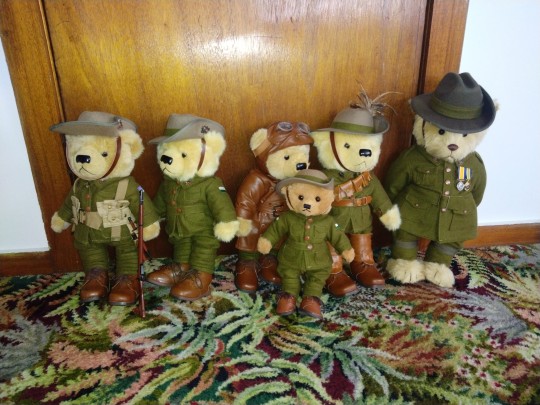
The oddly specific thing I collect is teddy bears in historical uniforms. So far, I only have WWI Australian. These ones are all from the same line, designed for the centenary of the war and in large part intended as educational tools for primary schools. All except the large and the small one came with names, some of whom were mentioned in the accompanying book, "John Murray's Diary" (one of those subscription books where you fill up a ring binder, it included commemorative pennies?? I have it as an E-Book).
The big one was sold as the "Spirit of Remembrance" bear, but I call him Horace. He's real mohair and there were 1,918 of him made to mark the centenary of the armistice. Next to him is Trooper Bert Jones the Light Horse bear with his emu feathers. The one in the helmet and goggles is Lieutenant Thomas Hendy the Australian Flying Corps bear. Next to him is Private John Murray, and next to Murray is Private Ernest Harvey the Gallipoli bear, with his webbing and rifle. Finally, the mini bear was sold as the "Little Digger" bear, and he came with blank attestation papers to "create your own story". I've named him Mervyn. His colour patches are 4th Battalion but I intend to change them to 12th.
In the future I hope to find Bernadette O'Meara the nurse bear, Able Seaman Miller the Navy bear, and a few others, but mostly those two. I'm also saving up for a replica Farnell mascot bear. These were miniature bears able to be carried in the pocket and they were very popular. They were available in the usual blonde mohair but also white, bright red, and blue.
3 notes
·
View notes
Text
(60)Psychology books
Meditations by Marcus Aurelius ✅
How to Analyze People with Dark Psychology
Reading People by Anne Bogel
How to Read People Like a Book
What Every Body Is Saying
The Secrets of Body Language
How To Analyze People
Read People Like a Book
Mindreader
You are not so smart
From the Diary of a Psychologist by Dr. Asha Dinesh
The Secret Life of Pronouns by James Pennebake
The Happiness Hypothesis by Jonathan Heidt
The Archetypes and The Collective Unconscious by Carl Jung
Sex at Dawn by Christopher Ryan
Man and His Symbols by Carl Jung
Memories, Dream, Reflections by Carl Jung
Wisdom of Psyche by Ginette Paris
Flow by Mihaly Csikszentmihalyi
Beyond Good And Evil by Friedrich Nietzsche
Behave by Robert Sapolsky
Thinking Fast & Slow
48 Laws of Power by Robert Greene
The Wellness Sense by Om Swami
The Nocturnal Brain
7.5 lessons about the brain
Range: Why Generalists Triumph in a Specialized World
Man's Search for Meaning by Viktor E. Frankl
The Social Animal by David Brooks
Influence: The Psychology of Persuasion by Robert B. Cialdini
An Unquiet Mind: A Memoir of Moods and Madness by Kay Redfield Jamison
The Road Less Traveled: A New Psychology of Love, Traditional Values, and Spiritual Growth by M. Scott Peck
The Art of Loving by Erich Fromm
The Man Who Mistook His Wife for a Hat and Other Clinical Tales by Oliver Sacks
Emotional Intelligence: Why It Can Matter More Than IQ by Daniel Goleman
The Interpretation of Dreams by Sigmund Freud
Stumbling on Happiness by Daniel Gilbert
Theories of Personality by Calvin S. Hall and Gardner Lindzey
The New Psycho-Cybernetics by Maxwell Maltz
The Bell Curve: Intelligence and Class Structure in American Life by Richard J. Herrnstein and Charles Murray
The Body Keeps the Score: Brain, Mind, and Body in the Healing of Trauma by Bessel van der Kolk
The Psychopath Test: A Journey Through the Madness Industry by Jon Ronson
The Righteous Mind: Why Good People Are Divided by Politics and Religion by Jonathan Haidt
Maps of Meaning: The Architecture of Belief by Jordan B. Peterson
A First-Rate Madness: Uncovering the Links Between Leadership and Mental Illness by Nassir Ghaemi
The Feeling Good Handbook by David D. Burns
Thinking About Psychology: The Science of Mind and Behavior by Charles T. Blair-Broeker and Randal M. Emst
The Evolution of Cooperation by Robert Axelrod
The Handbook of Psychological Testing by Paul Kline
. The Nature of Prejudice by Gordon W. Allport
The Origins of Totalitarianism by Hannah Arendt
The Psychopathology of Everyday Life by Sigmund Freud
The Structure of Scientific Revolutions by Thomas S. Kuhn
The Principles of Psychology" by William James
An Unquiet Mind: A Memoir of Moods and Madness" by Kay Redfield Jamison
"The Noonday Demon: An Atlas of Depression" by Andrew Solomon
Diagnostic and Statistical Manual of Mental Disorders" (DSM-5) by the American Psychiatric Association
5 notes
·
View notes
Text
Episode 168 - Holiday Romance
It's Valentine's Day, so this episode we’re talking about Holiday Romance! We discuss what counts as a holiday, Christmas, nostalgia, 1st vs. 3rd person narration, and how all the stories we read are “fine.” Plus: There’s only one bed!
You can download the podcast directly, find it on Libsyn, or get it through Apple Podcasts, Stitcher, Google Podcasts, or your favourite podcast delivery system.
In this episode
Anna Ferri | Meghan Whyte | Matthew Murray | Jam Edwards
Things We Read (or tried to…)
Kiss Her Once for Me by Alison Cochrun
Heartstopper by Alice Oseman
Someone to Trust by Mary Balogh
Yule Planet by Angel Martinez
Alaskan Holiday by Debbie Macomber
Other Media We Mentioned
The Red Satin Collection by Giselle Renarde
The Matzah Ball by Jean Meltzer (the Hanukkah one Jam mentioned)
Casper Gets His Wish by R. Cooper (the elf one Jam mentioned) (from Episode 063: Cheap eBooks)
The Frontier Romance: Environment, Culture, and Alaska Identity by Judith Kleinfeld
Links, Articles, and Things
Hark! Episode 328: Brand Synergy
When Is ‘Cuffing Season?’
New Christmas Movies You Can Stream This Season (2022)
How to watch all 172 new Christmas movies in December
Quiz: What Queer Holiday Romance Should You Read?
Escape from the Holidays
24-hour comic (Wikipedia)
20 Holiday Romance books by BIPOC (Black, Indigenous and People of Colour) Authors
Every month Book Club for Masochists: A Readers’ Advisory Podcasts chooses a genre at random and we read and discuss books from that genre. We also put together book lists for each episode/genre that feature works by BIPOC (Black, Indigenous, & People of Colour) authors. All of the lists can be found here.
The Holly Dates by Brittainy C. Cherry
Whiteout by Dhonielle Clayton, Tiffany D. Jackson, Nic Stone, Angie Thomas, Ashley Woodfolk, and Nicola Yoon
Sweet on You: A Filipino Romance by Carla de Guzman
Royal Holiday by Jasmine Guillory
Kwanzaa Angel by Shirley Hailstock
Mangos and Mistletoe by Adriana Herrera
Amor Actually: A Holiday Romance Anthology by Adriana Herrera, Alexis Daria, Diana Muñoz Stewart, Mia Sosa, Priscilla Oliveras, Sabrina Sol, and Zoey Castile
Merry Inkmas by Talia Hibbert
Tempted at Midnight by Cheris Hodges
One Christmas Wish by Brenda Jackson
Grand Theft N.Y.E. by Katrina Jackson
Gettin' Merry: A Holiday Anthology by Beverly Jenkins, Francis Ray, Geri Guillaume, and Monica Jackson
A Holly Jolly Diwali by Sonya Lalli
Holidays with the Wongs by Jackie Lau
Ready When You Are by Gary Lonesborough
Also published under the title The Boy From the Mish
The Holiday Switch by Tif Marcelo
Right Beside You by Mary Monroe
Love Me This Christmas by Jasmine Nicole
The Christmas Clash by Suzanne Park
All I Want Is You by Kayla Perrin and Deborah Fletcher Mello
Give us feedback!
Fill out the form to ask for a recommendation or suggest a genre or title for us to read!
Check out our Tumblr, follow us on Twitter or Instagram, join our Facebook Group, or send us an email!
Join us again on Tuesday, February 21st it’s time for What is a book? (part 2)!
Then on Tuesday, March 7th we’ll be discussing the genre of Gender Theory and Gender Studies!
2 notes
·
View notes
Text
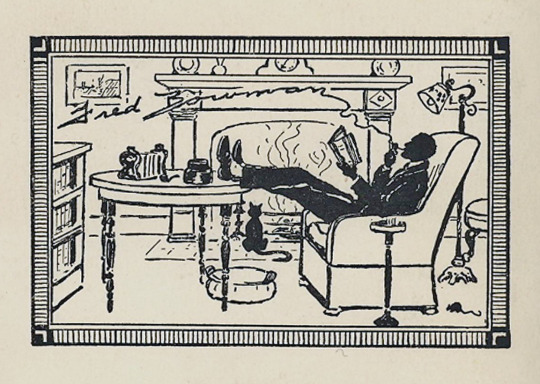
Bookplate for Fred Bowman. Source: University of British Columbia. Library. Rare Books and Special Collections. Thomas Murray Bookplates Collection. Leslie Binder.
#rare books#university of british columbia#bookplate#smoking pipe#pipemen#pipesmoking#pipes#fireplace#vintagemen#vintage#cat
2 notes
·
View notes
Text
2024 Grammy Awards: Full list of winners
This year’s Grammy Awards was held at the Peacock Theatre in Los Angeles, United States on Sunday.
Disappointingly, no Nigerian artiste was announced as winner at the 66th edition of the awards ceremony.
David Adeleke, aka, Davido; Damini Ogulu, aka Burna Boy; Ahmed Ololade, aka Asake; Olamide Adedeji, aka Baddo; and Oyinkansola Aderibigbe, aka Ayra Starr; all lost out in their combined 10 nominations across different award categories.
Here is the full list of winners:
Best African Music Performance
Amapiano – Asake and Olamide
City Boys – Burna Boy
Water – Tyla WINNER
Unavailable – Davido Featuring Musa Keys
Rush – Ayra Starr
Best Melodic Rap Performance
Sittin’ On Top Of The World – Burna Boy Featuring 21 Savage
Attention – Doja Cat
All My Life – Lil Durk Featuring J. Cole WINNER
Spin Bout U – Drake & 21 Savage
Low – SZA
Best Global Music Album
Epifanías — Susana Baca
History — Bokanté
I Told Them… — Burna Boy
This Moment – Shakti WINNER
Timeless — Davido
BEST RAP ALBUM
Her Loss – Drake & 21 Savage
Michael – Killer Mike WINNER
Heroes & Villains – Metro Boomin
King’s Disease III – Nas
Utopia – Travis Scott
PRODUCER OF THE YEAR, NON-CLASSICAL
Dernst “D’Mile” Emile II
Jack Antonoff – WINNER
Hit Boy
Metro Boomin
Daniel Nigro
SONGWRITER OF THE YEAR, NON-CLASSICAL
Edgar Barrera
Jessie Jo Dillon
Shane McAnally
Theron Thomas – WINNER
Justin Tranter
Best Global Music Performance
Shadow Forces – Arooj Aftab, Vijay Iyer & Shahzad Ismaily
Alone – Burna Boy
Pashto – Béla Fleck, Edgar Meyer & Zakir Hussain Featuring Rakesh Chaurasia WINNER
FEEL – Davido
Milagro Y Desastre – Silvana Estrada
Abundance In Millets – Falu & Gaurav Shah (Featuring PM Narendra Modi)
Best Album Notes
Evenings At The Village Gate: John Coltrane With Eric Dolphy (Live)
Written In Their Soul: The Stax Songwriter Demos – WINNER
I Can Almost See Houston: The Complete Howdy Glenn
Mogadishu’s Finest: The Al Uruba Sessions
Playing For The Man At The Door: Field Recordings From The Collection Of Mack McCormick, 1958–1971
Best Boxed Or Special Limited Edition Package
The Collected Works Of Neutral Milk Hotel
Gieo
For The Birds: The Birdsong Project – WINNER
Inside: Deluxe Box Set
Words & Music, May 1965 – Deluxe Edition
Best Music Film
How I’m Feeling Now -Lewis Capaldi
Live From Paris, The Big Steppers Tour – Kendrick Lamar
Moonage Daydream – David Bowie WINNER
I Am Everything – Little Richard
Dear Mama – Tupac Shakur
Best Music Video
In Your Love – Tyler Childers
I’m Only Sleeping – The Beatles WINNER
What Was I Made For – Billie Eilish
Count Me Out – Kendrick Lamar
Rush – Troye Sivan
Best Song Written For Visual Media
Barbie World
What Was I Made For? – WINNER
Dance The Night
I’m Just Ken
Lift Me Up
Best Score Soundtrack for Video Games and Other Interactive Media
Call Of Duty®: Modern Warfare II – Sarah Schachner
Hogwarts Legacy – Peter Murray, J Scott Rakozy & Chuck E. Myers “Sea”, composers
Star Wars Jedi: Survivor – Stephen Barton & Gordy Haab WINNER
God Of War Ragnarök – Bear McCreary, composer
Stray Gods: The Roleplaying Musical – Montaigne, Tripod & Austin Wintory, composers
Best Score Soundtrack For Visual Media (Includes Film And Television)
Black Panther: Wakanda Forever – Ludwig Göransson
Indiana Jones And The Dial Of Destiny – John Williams
Oppenheimer – Ludwig Göransson WINNER
Barbie – Mark Ronson & Andrew Wyatt
The Fabelmans – John Williams
Best Compilation Soundtrack For Visual Media
Aurora
Barbie The Album – WINNER
Black Panther: Wakanda Forever
Guardians of the Galaxy, Vol. 3: Awesome Mix, Vol. 3
Weird: The Al Yankovic Story
Best Comedy Album
I Wish You Would – Trevor Noah
I’m An Entertainer – Wanda Sykes
What’s In A Name? – Dave Chappelle – WINNER
Selective Outrage – Chris Rock
Someone You Love – Sarah Silverman
Best Engineered Album, Non-Classical
Desire, I Want To Turn Into You
History
Jaguar II – WINNER
Multitudes
The Record
Best Immersive Audio Album
God Of War Ragnarök (Original Soundtrack)
Act 3 (Immersive Edition)
The Diary Of Alicia Keys – WINNER
Blue Clear Sky
Silence Between Songs
Best Historical Album
Fragments – Time Out Of Mind Sessions (1996-1997): The Bootleg Series, Vol. 17
Written In Their Soul: The Stax Songwriter Demos – WINNER
The Moaninest Moan Of Them All: The Jazz Saxophone of Loren McMurray, 1920-1922
Playing For The Man At The Door: Field Recordings From The Collection Of Mack McCormick, 1958–1971
Words & Music, May 1965 – Deluxe Edition
Best Tropical Latin Album
Voy A Ti – Luis Figueroa
Siembra: 45º Aniversario (En Vivo en el Coliseo… – Rubén Blades… WINNER
Niche Sinfónico – Grupo Niche Y Orquesta Sinfónica Nacional de Colombia
VIDA – Omara Portuondo
MIMY & TONY – Tony Succar, Mimy Succar
Escalona Nunca Se Había Grabado Así – Carlos Vives
Best Gospel Album
I Love You – Erica Campbell
Hymns (Live) – Tasha Cobbs Leonard
The Maverick Way – Maverick City Music
All Things New: Live In Orlando – Tye Tribbett WINNER
My Truth – Jonathan McReynolds
Best Roots Gospel Album
Tribute To The King – The Blackwood Brothers Quartet
Echoes Of The South – Blind Boys Of Alabama WINNER
Songs That Pulled Me Through The Tough Times – Becky Isaacs Bowman
Meet Me At The Cross – Brian Free & Assurance
Shine: The Darker The Night The Brighter The Light – Gaither Vocal Band
Best Rap Album
Her Loss – Drake & 21 Savage
MICHAEL – Killer Mike WINNER
HEROES & VILLIANS – Metro Boomin
King’s Disease III – Nas
UTOPIA – Travis Scott
Best R&B Album
Girls Night Out – Babyface
JAGUAR II – Victoria Monét WINNER
What I Didn’t Tell You (Deluxe) – Coco Jones
Special Occasion – Emily King
CLEAR 2: SOFT LIFE EP – Summer Walke
Best Remixed Recording
Alien Love Call
New Gold (Dom Dolla Remix)
Reviver (Totally Enormous Extinct Dinosaurs Remix)
Wagging Tongue (Wet Leg Remix) – WINNER
Workin’ Hard (Terry Hunter Remix)
Read the full article
0 notes